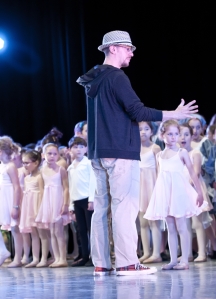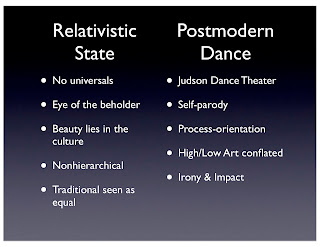Creative Process
In Making Your Life as an Artist, Andrew Simonet
writes, “The scientific method and the artistic process are the two most robust
problem-solving methodologies ever developed. Take either one away, and our
world would be unrecognizable.”
As an artist and educator, my life is built
around the practice, study, and teaching of the artistic or creative process. I
am passionate about it. It is what excites and energizes me to get up each day
and walk into the classroom or studio. However, incoming freshman dance majors,
students choosing to pursue fine arts degrees, often are more able to recite
the scientific method, or even elements of critical thinking, than they are
stages of the creative process.
I imagine that this is partly because we do not
give creative process much weight in our education systems and partly because
these students often believe in the myth that creativity is something that
starry-eyed, eccentrics are gifted with and the rest of us, the level-headed,
rational, or even mathematical types, just cannot learn.
Ken Robinson speaks to this in Out of Our Minds,
saying “If someone tells you they cannot read or write, you don’t assume that
they are not capable of reading and writing, but that they haven’t been taught
how. It is the same with creativity. When people say to me that they are not
creative, I assume they just haven’t yet learnt what is involved.”
So I teach, study, and practice creative process,
which has different approaches and frameworks, just like models of the
scientific method or critical thinking. I personally teach a seven-stage model
that goes from ideation to generation to development, forming, composing,
performing, and reviewing. I believe whole-heartedly that creativity can be
learned…and I am going to tell you why I believe this.
You see, I have a confession to make. One that
may cause me to lose the respect of my colleagues in the arts, I hope you all
respect me in the morning, but I feel I must come clean…in High School…I was on
the math team. I know, embarrassing.
I was far from the starry-eyed, eccentric with
the gift for creativity. I was not a “natural.” It was something I had to work
on tirelessly and passionately. So, naturally, I believe in the ability to
teach and train someone to be creative. But it is more than that, I believe that
the creative process is a skill that is as rigorous and necessary as the
scientific method for life in the 21st century.
At the University of California San Diego,
faculty and student researchers in the Department of Cognitive Science take
creative process seriously too, so much so that they undertook a detailed
ethnographic study of the creative process of British choreographer Wayne
McGregor.
McGregor is artistic director of Random Dance,
which he started in the 1990s, and has won scores of awards and distinctions
some of which include five Olivier Awards, one Grammy, and the title Commander
of the Order of the British Empire. For this study, they attached video cameras
at every angle in the dance studio in addition to a 16-camera motion capture
system, had teams of students lining the studio perimeter with notebooks
documenting every minute, interviewed the dancers daily and the choreographer
22 times, administered psychological tests on all involved, and documented
their diaries and journals.
Among their findings was that the methods of
instruction McGregor demonstrated always fell in one of three categories:
Showing, Making On, and Tasking. In Showing, McGregor demonstrates the movement
information he is passing on and asks the dancers to replicate it.
The second method of instruction is Making On,
where McGregor makes movement on target dancers, using them as architectural
objects. Instead of McGregor generating ideas from within himself, he interacts
with others in the moment, letting their bodies, their personalities, and their
skill influence the creative process.
The third method of instruction is Tasking,
where the choreographer poses a movement problem and asks the dancers to solve
it on their own. The choreographer allows the dancers to discover movement
information for themselves, only guiding the task assignments. You can view a Ted Talk by Wayne McGregor using
these three methods here: Wayne McGregor: A choreographer's process in real time.
Here is something intriguing from this study.
The researchers found that the movement information gathered from Showing was
high quality and efficient, but lacked novelty. By high quality, they mean that
it often leads to ideas that make it into the final presentation, presumably
because it comes from the most experienced movement maker. By efficient, they
mean that it takes the shortest amount of time to come up with usable ideas. I’m
the choreographer, I teach it to you, you do it, quick and easy. And, by lacking
novelty, they mean that these otherwise high quality and efficient ideas seldom
break new ground, they rarely lead to innovation.
By contrast, the third method, Tasking, was
highly novel but low quality and inefficient. The most innovative ideas came
out of Tasking, but they took time to get through the multitude of low quality
answers to the movement problem.
This study told McGregor, with all his awards
and distinctions, that the ideas he directly created through showing were far
less innovative than the ones that emerged through his dancers in Tasking.
That, as he loosened his grip, more creativity entered.
This finding, that the method whereby the
expert, the most experienced mover, acting alone to generate movement ideas is
less innovative than tapping into the creative innovation of others can be hard
to swallow. It challenges our long held myth of the individual genius, the
solitary expert who grips tightly to a concept until they discover what the
masses could never see.
And yet, this realization gets to the core of
creative process, that simply focusing harder in one direction to find an
answer likely will not lead to innovation. In order to increase the chances for
innovation, we need to also widen our focus to see the multitude of
possibilities. We need to integrate our critical thinking with creative
process.
Why?
Because when we grip our ideas tightly, whether
they are our artistic babies or our research, we can hold them up and say this
is so, and it is likely to be a high quality concept that others—students for
example—can learn efficiently. But that grip can squeeze the life and creativity
out of it.
When we present our ideas to others and let them
work with them, by presenting them in performance or publication, we let others
engage with our ideas—knead them, prod them, test them, critique them—we open
up to more creative potential, but at some risk.
And when we completely loosen our grips and
gently provide the support, for others to engage, not just with our ideas, but,
with the creative process itself—which can be messy, slow, even risky—we open
to the path where creative process can lead us to innovation.
We have all gripped tightly to
our areas of expertise, because, afterall, expertise is a survival skill…we
need to publish and present for promotion and longevity. But, as our world
becomes increasingly more digitized, globalized, and outsourced, creative
process may be an even more vital survival skill for the 21st
century. Yes, there seems to be little time for the messy, inefficient path
that is the creative process…but what are we missing by not walking that path.
Others have already started
down that path. The Rhode Island School of Design and Brown University have
been working to add the Arts into STEM to make it STEAM. Discussions started by
Senior Editor of the Harvard Business Review Katherine Bell’s article, The MFA is the new MBA, bring to the
forefront the value of creative process in the business field.
So, I cannot help wondering what
would happen if we allowed creative process to work within our university and
local communities the same way we do critical thinking?
What would happen if I stepped
out of my individual silo of expertise and into the liminal space that exists
in the university or community at large to explore research that combines
fields not usually considered congruent?
What would happen if, instead
of following the well-trodden path of almost every other organization and institution
with the practice of professional siloing, we made creative process a priority?
In our current climate
where organizations are struggling with enrollment, funding support, and a
changing landscape, continuing to just do more of what has been done in the
past offers little promise. To paraphrase Maslow, if the only tool we know is a
hammer, every problem looks like a nail. We need the creative process and to apply
it to the issues in front of us, because as Ken Robinson puts it, “We will not
succeed in navigating the complex environment of the future by peering
relentlessly into the rearview mirror. To do so, we would be out of our minds.”


Comments
Post a Comment